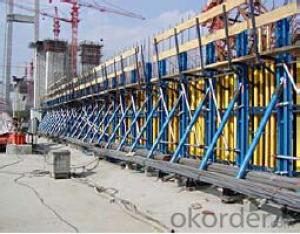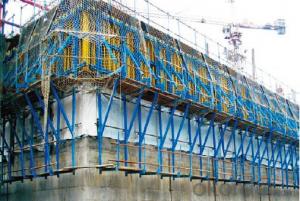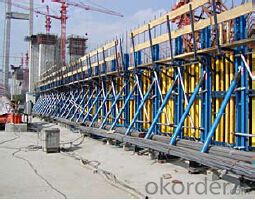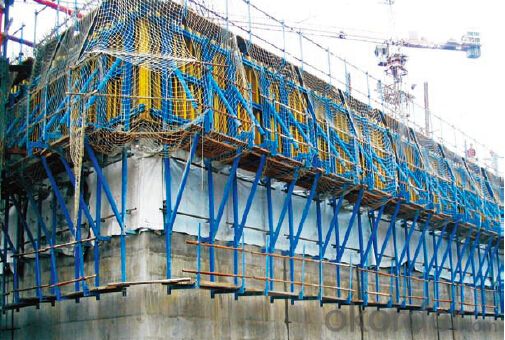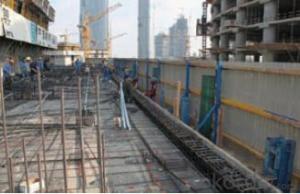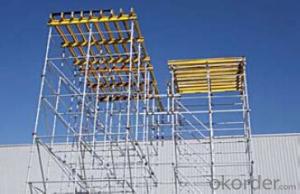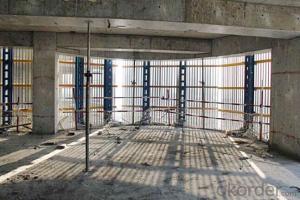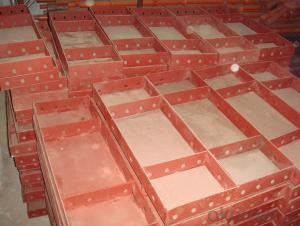Single-Side Climbing bracket for formwork and scaffolding systems
- Loading Port:
- Tianjin
- Payment Terms:
- TT OR LC
- Min Order Qty:
- 50 m²
- Supply Capability:
- 1000 m²/month
OKorder Service Pledge
OKorder Financial Service
You Might Also Like
Single-side Climbing Bracket SCB180:
With CNBM SCB 180 climbing systems, the loads from the fresh concrete pressure are
transferred through the brackets by means of V-strongbacks and compression braces into the
scaffold anchors.
Typical applications for the SCB 180 are dams, locks, cooling towers, pier heads, tunnels, and
bank vaults.
The formwork is simply tilted backwards when striking takes place. The 1.80 m wide bracket
requires only a minimum of space.
Characteristics:
◆ Economical and safe anchoring
The M30/D20 climbing cones have been designed especially for single-sided concreting using
SCB180 in dam construction, and to allow the transfer of high tensile and shear forces into the still
fresh, unreinforced concrete. Without wall-through tie-rods, finished concrete is perfect.
◆ Stable and cost-effective for high loads
generous bracket spacings allow large-area formwork units with optimal utilization of the bearing
capacity. This leads to extremely economical solutions.
◆ Simple and flexible planning
With SCB180 single-sided climbing formwork, circular structures can also be concreted without
undergoing any large planning process. Even use on inclined walls is feasible without any special
measures because additional concrete loads or lifting forces can be safely transferred into the
structure.
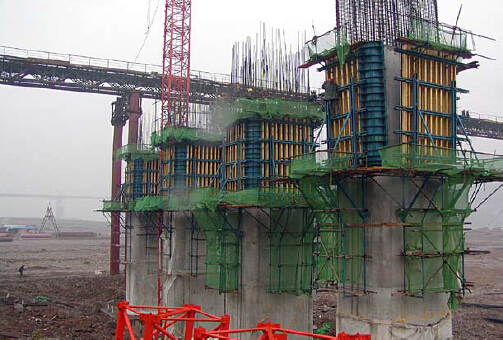
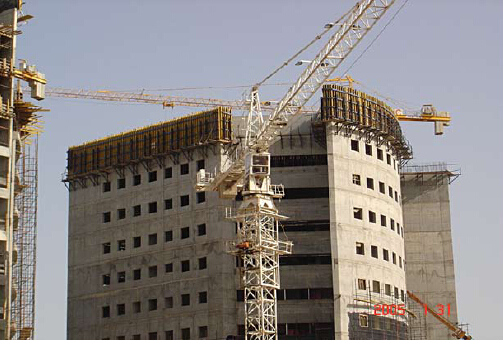
- Q: What are the different accessories and attachments available for steel formwork?
- There are several accessories and attachments available for steel formwork, including form ties, formwork clamps, formwork braces, formwork connectors, formwork wedges, formwork pins, formwork screws, and formwork anchors. These accessories and attachments are essential for securely and effectively assembling and reinforcing the steel formwork, ensuring stability and accuracy during the concrete pouring process.
- Q: Can steel formwork be used for energy-efficient concrete buildings?
- Energy-efficient concrete buildings can utilize steel formwork. The strength, durability, and versatility of steel formwork make it a suitable option for constructing energy-efficient structures. Precise design and construction are achievable with steel formwork, which is essential for achieving energy efficiency in buildings. Architects and engineers can customize steel formwork to create intricate designs and complex shapes, allowing for the incorporation of energy-efficient features like insulated walls, solar shading devices, and efficient HVAC systems. Furthermore, steel formwork offers excellent thermal conductivity, which helps maintain consistent indoor temperatures and reduces energy consumption. By using steel formwork, concrete walls and floors can be designed with insulation materials that provide high thermal resistance, minimizing heat transfer through the building envelope. This reduces the energy required for heating and cooling, resulting in improved energy efficiency. In addition, steel formwork is easily reusable, reducing construction waste and promoting sustainability. It can be dismantled and reassembled for multiple projects, making it a cost-effective and environmentally friendly choice. Choosing steel formwork for energy-efficient concrete buildings not only minimizes energy consumption but also reduces the overall environmental impact. To conclude, steel formwork is an effective choice for constructing energy-efficient concrete buildings. Its strength, durability, versatility, and thermal conductivity make it suitable for incorporating energy-efficient features into the building design. Moreover, its reusability promotes sustainability, making steel formwork a viable option for creating energy-efficient structures.
- Q: How does steel formwork contribute to improved construction site access?
- Improved construction site access is facilitated by steel formwork in various ways. Firstly, the durability and reliability of steel formwork enable the construction of robust and stable structures. As a result, workers can navigate the formwork with confidence, assured of its stability and integrity. Secondly, the highly versatile nature of steel formwork allows for customization according to the specific requirements of any project. This flexibility enables the creation of intricate shapes and designs, improving access to different areas of the construction site. For instance, curved or inclined formwork can be utilized to construct ramps, staircases, or other access points that facilitate movement and navigation. Moreover, steel formwork is renowned for its exceptional load-bearing capacity, enabling it to support heavy loads and equipment. This is especially crucial in construction projects involving cranes, scaffolding, or other substantial machinery. By providing a sturdy platform, steel formwork ensures that access is maintained even during the transportation of heavy loads across the site. Furthermore, the quick and effortless assembly of steel formwork significantly reduces construction time and enhances on-site access. Its modular design allows for efficient installation and dismantling, enabling access points to be created or modified promptly. This proves particularly advantageous in time-sensitive projects or situations where the site layout requires frequent adaptation. To conclude, steel formwork contributes to improved construction site access through its durability, versatility, load-bearing capacity, and ease of assembly. These attributes not only enhance worker safety but also facilitate movement around the site, ultimately optimizing productivity and efficiency in the construction process.
- Q: What is steel formwork?
- Steel formwork is a type of temporary structure made from steel that is used in construction projects to create the desired shape and structure of concrete elements such as walls, columns, and slabs. It provides a strong and durable framework for the concrete during the pouring and curing process, ensuring accuracy and stability in the final structure.
- Q: Can steel formwork be used in areas with high chemical exposure?
- While steel formwork can be utilized in areas characterized by high levels of chemical exposure, it may not necessarily be the most optimal selection. Although steel is generally recognized as a resilient and robust substance, it is prone to corrosion upon encountering specific chemicals. In situations where the chemicals prevalent within the vicinity are known to induce corrosion in steel, it is advisable to contemplate alternative formwork materials like plastic or aluminum, which possess a higher resistance to chemical exposure. Moreover, it is feasible to enhance the steel formwork's chemical resistance by applying protective coatings or treatments. Nonetheless, it is crucial to thoroughly assess the particular chemicals and their concentration within the area in order to ascertain the most suitable formwork material for the project.
- Q: How does steel formwork contribute to the sustainability of a construction project?
- There are several ways in which steel formwork contributes to the sustainability of construction projects. Firstly, its high durability and long lifespan allow for multiple uses, reducing the need for new formwork and minimizing waste. This also means that frequent repairs or replacements are unnecessary, saving time and resources. Secondly, steel formwork is a reusable material that can be easily disassembled and reassembled for different projects. This reduces the demand for new formwork and decreases the amount of waste generated, thereby reducing the environmental impact of construction projects. Additionally, steel formwork is highly efficient and enables faster construction times. Its strength and stability allow for quicker progress, ultimately reducing the overall duration of the project. This not only saves time but also decreases energy consumption, contributing to the project's overall sustainability. Furthermore, steel formwork is recyclable. At the end of its lifespan, it can be recycled, further reducing its environmental impact. Recycling steel requires less energy and resources compared to manufacturing new steel, resulting in lower greenhouse gas emissions and conservation of natural resources. In conclusion, steel formwork plays a crucial role in promoting sustainability in construction projects. Its durability, reusability, efficiency, and recyclability all contribute to reducing the need for new formwork, minimizing waste, saving construction time, and conserving resources. By incorporating steel formwork, builders can significantly decrease the environmental impact while ensuring long-term durability and efficiency.
- Q: How does steel formwork affect the overall speed of construction?
- The numerous advantages of steel formwork greatly contribute to the overall speed of construction. Firstly, its high durability ensures that it can withstand the pressure of concrete pouring without any deformation or damage. This durability allows for multiple reuses of the formwork, eliminating the need for constant replacement with new materials and saving both time and cost. Furthermore, steel formwork provides a smooth and even surface finish, which reduces the time needed for additional plastering or finishing work. This smooth finish also guarantees accurate alignment of structural elements, resulting in faster and more efficient construction. In addition, the ease of assembly and disassembly of steel formwork facilitates quick installation and removal. This user-friendly feature eliminates the need for extensive labor and minimizes the time required for formwork setup, ultimately accelerating the construction process. Moreover, steel formwork is highly adaptable and can be used in various types of building structures. Its flexibility allows for customization and efficient utilization in different construction projects, further enhancing the overall speed of construction. In conclusion, the utilization of steel formwork has a positive impact on the speed of construction by offering durability, a smooth finish, ease of assembly and disassembly, and adaptability. These advantages result in time and cost savings, efficient construction processes, and ultimately faster project completion.
- Q: Can steel formwork be used for underground culverts?
- Yes, steel formwork can be used for underground culverts. Steel formwork is durable and strong, making it suitable for withstanding the pressure and weight of the surrounding soil and water in underground culverts. It provides a stable and rigid structure that can be easily assembled and disassembled, allowing for efficient construction and maintenance of underground culverts.
- Q: How does steel formwork affect the overall weight of the structure?
- Steel formwork can have a significant impact on the overall weight of a structure. Compared to traditional timber formwork, steel formwork is generally heavier due to the inherent properties of steel. Steel is denser and heavier than wood, which means that steel formwork will contribute more to the overall weight of the structure. However, the weight of the steel formwork can also be advantageous in certain situations. The increased weight of steel formwork can provide stability and rigidity to the structure during the construction process, ensuring that the concrete is properly supported and shaped. This can lead to a more precise and durable final structure. Moreover, steel formwork is typically more durable and can be reused multiple times, whereas timber formwork often needs to be replaced after a few uses. This can result in a reduced environmental impact and cost savings in the long run, even though steel formwork may initially add more weight to the structure. Ultimately, the effect of steel formwork on the overall weight of a structure depends on various factors such as the size and complexity of the project, the specific design requirements, and the construction method chosen. However, it is important to consider the trade-offs between the weight of the formwork and its benefits in terms of stability, durability, and cost-effectiveness.
- Q: How does steel formwork affect the overall construction site waste recycling?
- The overall waste recycling at a construction site can be greatly influenced by steel formwork. In contrast to traditional timber formwork, steel formwork is more long-lasting and can be reused multiple times. This results in a decrease in waste production at the construction site since there is less necessity for the production and disposal of new formwork materials. Furthermore, cleaning and maintaining steel formwork is simpler, which extends its lifespan and reduces the need for replacement. This not only decreases waste but also saves costs associated with purchasing new formwork materials for each construction project. Moreover, steel formwork is highly recyclable. Once its life cycle is complete, it can be recycled and utilized to manufacture new steel products, diminishing the demand for fresh materials and reducing the environmental impact. Through the utilization of steel formwork, construction sites can greatly diminish their waste generation and contribute to a more sustainable construction industry. This not only benefits the environment but also promotes a more efficient and cost-effective approach to construction.
Send your message to us
Single-Side Climbing bracket for formwork and scaffolding systems
- Loading Port:
- Tianjin
- Payment Terms:
- TT OR LC
- Min Order Qty:
- 50 m²
- Supply Capability:
- 1000 m²/month
OKorder Service Pledge
OKorder Financial Service
Similar products
Hot products
Hot Searches
